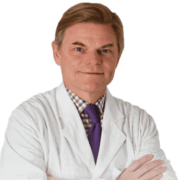Advances in Breast Care

by Leslie Cardé
WHEN ANGELINA JOLIE CHOSE to have a prophylactic double mastectomy in 2013, despite not being diagnosed with breast cancer, it left many wondering why. Jolie had learned she had a genetic mutation called BRCA, which put her at a heightened risk for breast cancer. Many more women since that time have opted to have the same procedure in order to ensure that breast cancer would not be a part of their future, and have chosen to have all breast tissue removed.
For patient Sarah Olivier, it would be a different genetic syndrome which put her at risk for a variety of cancers, including breast cancer. Because her aunt had breast cancer at the age of 43, Sarah began getting mammograms at the age of 35. With dense breast tissue, there were always questions as to whether the mammogram could be a definitive diagnosis, so radiologists would recommend an ultrasound and often an MRI, as well. Suspicious lesions would often involve biopsies in which small pieces of tissue were removed for analysis. Over the next 12 years, Olivier would have five biopsies because of suspicious radiology. Every time she waited for the results, it was agonizing.
“At that point, I decided to have genetic testing, which was done in December 2019,” remembers Olivier. “The genetic testing came back positive for Lynch syndrome, a rare condition that put me at a much greater risk for many cancers, including breast. I went to see my ob/gyn doctor, who referred me to breast surgeon Dr. John Colfry, who told me he had rarely seen a patient who had already had five biopsies, and that I was quite literally a walking time bomb.”
In this particular patient’s case, not only was there the genetic component, but her family history created an exponential problem. Not only was her aunt an issue, but Olivier’s own mother had been diagnosed years earlier with colon cancer—another Lynch syndrome cancer.
“Genetic testing has become much more sophisticated of late,” says Colfry. “Twenty years ago we tested for the BRCA 1 and 2 genes. These days there are nearly 40 gene mutations that we can find… among them Lynch syndrome. It’s not one of the common ones, and breast cancer is certainly on the spectrum, but not as strong as colon cancer. However, her strong family history along with that gene mutation caught my attention.”
Mastectomies, once upon a time, were disfiguring. Reconstructive techniques were not as sophisticated, and the old radical mastectomies included removal of underarm lymph nodes and chest muscles. Nowadays, only the tissue from the breast itself is taken, and the nipple and surrounding areola are spared whenever possible. The empty cavity is then filled with either tissue from the patient’s abdomen, or additionally from an inner thigh, depending upon how much tissue is needed and how much the patient has to spare. And, an implant is often tucked away in the fat layers, making it a hybrid or composite procedure. The scars are all hidden underneath the new breast.
“Trends have changed considerably to a much more natural type of reconstruction,” says Dr. Ravi Tandon, a fellowship trained microsurgical breast reconstruction specialist or artist. “Breast replacement surgery avoids the necessity of radiation, which is required with a lumpectomy which only removes the cancerous tissue. But, with this particular kind of reconstruction, to give the patient the most natural look, we must decide if indeed the patient has enough surplus abdominal tissue and much like in a cosmetic tummy tuck, we take the excess skin, and use it to fill the new breast. Breast cancer will not return to non- breast tissue obtained from the abdomen, thigh, or lower back.”
Advances in implants have made them safer, which is of primary importance. For decades, breast enhancement, a cosmetic procedure, has used both saline and silicone implants. There were pros and cons to each. Silicone always looked more natural, but a rupture could spread silicone throughout the bloodstream. Saline was safer, but didn’t have the preferred cosmetic result. Newer implants have the best of both worlds.
“They are made of a highly cohesive silicone gel, as opposed to a liquid,” says Dr. Tandon. “The material stays together like a gummy bear, so if there is some sort of trauma to the breast, the material won’t travel anywhere. But, when considering whether to use an implant, the age of the patient should be considered. The life of an implant, statistically, is around 20 years, at which time it would need to be replaced, so it’s not always practical in very young patients, and should be discussed with each individual.”
Sadly, women are contracting breast cancer at increasingly younger ages. In general, it’s become more prevalent over the decades, but to see very young patients is startling, even for the medical breast experts.
“We see a massive younger population of late,” says Dr. Colfry. “It’s rampant, actually. It’s not unexpected to see women with cancer in their 50’s, 60’s or 70’s. But, we are now seeing lots of women in their 30’s, and we currently have a patient who is 21 years old, and just had a double mastectomy, because her chances of getting another cancer were high.”
Statistics show that the percentage of breast cancers are indeed rising, although no one is sure exactly why. Speculation points to the environment, diet, and obesity, but nothing is certain. What is certain is that the risk of breast cancer used to be one out of 10 women. The current percentage rate is 12.3%, nearly one out of every eight women.
What Drs. Tandon and Colfry both know is that although the numbers may be going in the wrong direction, new technology has afforded both patients diagnosed with cancer and those who choose mastectomies as a preventive method, results that had never been possible just a short time ago. Many patients feel they look just as they did before their surgeries, or even better, considering that the by-product of the mastectomy is often a tummy tuck and a breast lift.
“I had all the concerns you would expect when debating about prophylactically having my breasts removed,” remembers Olivier. “Since I hadn’t actually been diagnosed with cancer, I had lots of time to research the latest techniques and the best surgeons. I knew I wanted to look like I did before the surgery. I am 49 years old, and still wanted to wear the clothing I had been accustomed to without looking disfigured. And, I didn’t want the numbness that has long been associated with this surgery, so I looked for a reconstructive surgeon who would address all of my issues.”
“During a mastectomy, everything is removed, including nerves,” recounts Dr. Tandon. “Microsurgical techniques have improved markedly over the years. Six months ago, I wasn’t reconnecting nerves, but now I am. I connect from the nipple stump where there had previously been a nerve, find sensory nerves in the abdominal tissue and connect them together. Regeneration takes time. Nerves grow at a rate of about a millimeter a day. So, a breast takes about 18 months to get sensation back. The data coming out of Memorial Sloan-Kettering, where
I trained, has shown encouraging results on this next frontier. We as reconstructive surgeons have primarily been concerned about what the new breasts will look like, and now it’s about what they feel like, as well.”
For Sarah Olivier, whose surgery included nerve grafts, it’s a wait and see game. But, so far, her surgery which took place seven months ago, looks promising. “I was evaluated with the representative from Resensation, (a company that develops techniques for nerve regeneration),” explains Olivier. “I was put through a battery of tests to figure out where I had sensation and just how much. Since I was only a matter of months, post- op, I was told I had a lot of sensation. I think people need to understand that this isn’t just about erotic sensation. Without feeling in your breasts, you can burn yourself and not know it because the area is numb. You can come out of your bathing suit, and not be aware of it. I considered this to be a very necessary and worthwhile procedure, and it only added about 30 minutes of operating room time to my surgery.”
For the team of Colfry and Tandon, who have worked together as a team for about six years now, their training is stellar by any measure. Dr. John Colfry is among a few elite breast surgical oncologists in our entire region. Following medical school at LSU in Shreveport,
he completed general surgery training at Atlanta Medical Center, then specialized in surgical breast oncology at MD Anderson Cancer Center in Houston.
Dr. Ravi Tandon is one of a very few microsurgical fellowship-trained plastic and reconstructive surgeons in New Orleans. After medical school at Vanderbilt University and general surgery training at Tulane University, he specialized in plastic surgery at Albert Einstein College in New York City. He then completed a microsurgery fellowship at NYU, focusing on advanced microsurgical breast reconstruction techniques.
A breast cancer diagnosis can be frightening. Finding out you have a heightened susceptibility for breast cancer due to a genetic mutation can be equally so. However,
the road can be much less bumpy in the hands of skilled, compassionate professionals.
“I am 100% relieved that I made the decision to have a preventive double mastectomy,” points out Olivier. “And, I couldn’t have asked for a better team, including all of the nurses involved. I got a notification recently, as I do every six months, that it was time to schedule another imaging of my breasts. I called them back and told them to take me off of their list…. permanently! Living without that looming anxiety any longer means absolutely everything.”
For more information, visit ravitandonmd.com or call Dr. Tandon’s office at 504-455-1000. Call Dr. Colfry’s office at (504) 325-2900, or visit his website at lcmchealth.org/physician-directory/alfred-colfry-iii-md/.
Contact reporter Leslie Cardé at leslieinolamag@gmail.com.







